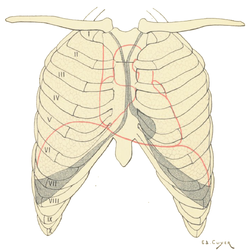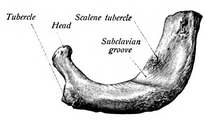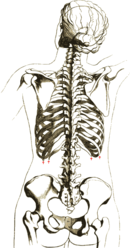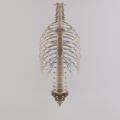What Makes the Ribs Flexible Again
| Rib cage | |
|---|---|
 The human rib cage. (Source: Greyness'south Anatomy of the Human Torso, 20th ed. 1918.) | |
 Protection on the rib cage of the middle, lungs and diaphragm. The shaded areas indicate the extent of the pleural cavities non filled past the lungs. | |
| Details | |
| Identifiers | |
| Latin | cavea thoracis |
| MeSH | D000070602 |
| TA98 | A02.3.04.001 |
| TA2 | 1096 |
| FMA | 7480 |
| Anatomical terminology [edit on Wikidata] | |
The rib cage, as an enclosure that comprises the ribs, vertebral cavalcade and sternum in the thorax of nigh vertebrates, protects vital organs such as the heart, lungs and great vessels.
In humans, the rib cage and the sternum, together known every bit the thoracic cage, is a semi-rigid bony and cartilaginous construction which surrounds the thoracic cavity and supports the shoulder girdle to form the cadre office of the human skeleton. A typical human thoracic cage consists of 12 pairs of ribs and the adjoining costal cartilages, the sternum (along with the manubrium and xiphoid process), and the 12 thoracic vertebrae articulating with the ribs. Together with the skin and associated fascia and muscles, the thoracic cage makes up the thoracic wall and provides attachments for extrinsic skeletal muscles of the neck, upper limbs, upper abdomen and dorsum.
The rib muzzle intrinsically holds the muscles of respiration (diaphragm, intercostal muscles, etc.) that are crucial for active inhalation and forced exhalation, and therefore has a major ventilatory function in the respiratory system.
Structure [edit]
Ribs are described based on their location and connexion with the sternum. All ribs are fastened posteriorly to the thoracic vertebrae and are numbered accordingly ane to twelve. Ribs that articulate direct with the sternum are called true ribs, whereas those that practice not clear straight are termed false ribs. The imitation ribs include the floating ribs (11 and twelve) that are not attached to the sternum at all.

Human rib cage -CT scan (parallel projection (left) and perspective project (right))
Attachment [edit]

true / fixed ribs
imitation ribs
false and floating ribs
The terms true ribs and false ribs describe rib pairs that are directly or indirectly fastened to the sternum. The offset vii rib pairs known as the fixed or vertebrosternal ribs are the true ribs (Latin: costae verae) as they connect straight to the sternum; the next five pairs (eighth to 12th) are the fake ribs (Latin: costae spuriae). The imitation ribs include both vertebrochondral ribs and vertebral ribs. In that location are three pairs of vertebrochondral ribs (eighth to tenth) that connect indirectly to the sternum via the costal cartilages of the ribs above them.[1] [2] Their elasticity allows rib cage movement for respiratory activity.
The phrase floating rib or vertebral rib (Latin: costae fluctuantes) refers to the two lowermost, the eleventh and twelfth rib pairs; and so-chosen because they are attached only to the vertebrae–and not to the sternum or cartilage of the sternum. These ribs are relatively small and fragile, and include a cartilaginous tip.[3]
The spaces between the ribs are known as intercostal spaces; they contain the intercostal muscles, and neurovascular bundles containing nerves, arteries, and veins.[4]
Parts of rib [edit]
Each rib consists of a caput, neck, and a shaft. All ribs are attached posteriorly to the thoracic vertebrae. They are numbered to lucifer the vertebrae they attach to – one to twelve, from top (T1) to bottom. The head of the rib is the end office closest to the vertebra with which it articulates. It is marked by a kidney-shaped articular surface which is divided by a horizontal crest into ii articulating regions. The upper region articulates with the inferior costal facet on the vertebra above, and the larger region articulates with the superior costal facet on the vertebra with the same number. The transverse process of a thoracic vertebra too articulates at the transverse costal facet with the tubercle of the rib of the same number. The crest gives attachment to the intra-articular ligament.[five]
The neck of the rib is the flattened part that extends laterally from the head. The neck is about three cm long. Its anterior surface is flat and smooth, whilst its posterior is perforated by numerous foramina and its surface rough, to give attachment to the ligament of the neck. Its upper border presents a rough crest (crista colli costae) for the attachment of the anterior costotransverse ligament; its lower border is rounded.
On the posterior surface at the neck, is an eminence—the tubercle that consists of an articular and a non-articular portion. The articular portion is the lower and more medial of the 2 and presents a small, oval surface for joint with the transverse costal facet on the end of the transverse process of the lower of the two vertebrae to which the head is connected. The non-articular portion is a crude elevation and affords attachment to the ligament of the tubercle. The tubercle is much more prominent in the upper ribs than in the lower ribs.
The angle of a rib (costal angle) may both refer to the bending role of it, and a prominent line in this area, a petty in front of the tubercle. This line is directed downwardly and laterally; this gives attachment to a tendon of the iliocostalis musculus. At this point, the rib is bent in two directions, and at the same time twisted on its long axis.
The distance between the angle and the tubercle is progressively greater from the second to the 10th ribs. The area between the angle and the tubercle is rounded, rough, and irregular, and serves for the zipper of the longissimus dorsi musculus.
Basic [edit]
Ribs and vertebrae [edit]
The outset rib (the topmost one) is the most curved and normally the shortest of all the ribs; it is wide and flat, its surfaces looking upward and downward, and its borders inwards and outward.
-

First rib seen from in a higher place
-

Costal groove position on a primal rib

The head is small and rounded, and possesses simply a single articular facet, for joint with the body of the first thoracic vertebra. The neck is narrow and rounded. The tubercle, thick and prominent, is placed on the outer border. Information technology bears a small facet for articulation with the transverse costal facet on the transverse process of T1. At that place is no angle, merely at the tubercle, the rib is slightly aptitude, with the convexity upwards, so that the head of the bone is directed down. The upper surface of the body is marked by 2 shallow grooves, separated from each other by a slight ridge prolonged internally into a tubercle, the scalene tubercle, for the zipper of the inductive scalene; the inductive groove transmits the subclavian vein, the posterior the subclavian avenue and the everyman trunk of the brachial plexus. Behind the posterior groove is a crude area for the attachment of the medial scalene. The under surface is smooth and without a costal groove. The outer border is convex, thick, and rounded, and at its posterior part gives zipper to the kickoff digitation of the serratus anterior. The inner edge is concave, thin, and sharp, and marked nigh its eye past the scalene tubercle. The anterior extremity is larger and thicker than that of any of the other ribs.
The second rib is the second uppermost rib in humans or second nearly frontal in animals that walk on four limbs. In humans, the 2nd rib is divers as a true rib since information technology connects with the sternum through the intervention of the costal cartilage anteriorly (at the front end). Posteriorly, the second rib is continued with the vertebral column by the 2d thoracic vertebra. The second rib is much longer than the first rib, simply has a very like curvature. The not-articular portion of the tubercle is occasionally only feebly marked. The angle is slight and situated close to the tubercle. The body is not twisted so that both ends bear upon any plane surface upon which it may exist laid; simply there is a bend, with its convexity upwardly, similar to, though smaller than that establish in the start rib. The body is not flattened horizontally like that of the start rib. Its external surface is convex, and looks upward and a footling outward; nigh the middle of it is a rough eminence for the origin of the lower part of the commencement and the whole of the second digitation of the serratus inductive; behind and above this is attached the posterior scalene. The internal surface, smooth, and concave, is directed downward and a little in: on its posterior part at that place is a brusk costal groove between the ridge of the internal surface of the rib and the junior border. It protects the intercostal space containing the intercostal veins, intercostal arteries, and intercostal nerves.[6] [iv]
The ninth rib has a frontal office at the same level equally the offset lumbar vertebra. This level is called the transpyloric plane, since the pylorus is as well at this level.[seven]
The 10th rib attaches directly to the body of vertebra T10 instead of betwixt vertebrae like the second through ninth ribs. Due to this straight attachment, vertebra T10 has a consummate costal facet on its torso.[3]

The iv floating ribs indicated
The eleventh and 12th ribs, the floating ribs, have a single articular facet on the caput, which is of rather large size. They take no necks or tubercles, and are pointed at their anterior ends. The eleventh has a slight angle and a shallow costal groove, whereas the twelfth does non. The twelfth rib is much shorter than the eleventh rib, and only has a one articular facet.[8]
Sternum [edit]
The sternum is a long, apartment bone that forms the front of the rib muzzle. The cartilages of the top vii ribs (the true ribs) join with the sternum at the sternocostal joints. The costal cartilage of the second rib articulates with the sternum at the sternal bending making it easy to locate.[nine]
The transversus thoracis muscle is innervated by ane of the intercostal fretfulness and superiorly attaches at the posterior surface of the lower sternum. Its inferior zipper is the internal surface of costal cartilages two through half-dozen and works to depress the ribs.[10]
Development [edit]
Expansion of the rib cage in males is caused past the furnishings of testosterone during puberty.[eleven] Thus, males generally have broad shoulders and expanded chests, allowing them to inhale more air to supply their muscles with oxygen.

Variation [edit]
Variations in the number of ribs occur. About i in 200–500 people have an additional cervical rib, and there is a female predominance.[12] Intrathoracic supernumerary ribs are extremely rare.[13] The rib remnant of the 7th cervical vertebra on ane or both sides is occasionally replaced by a gratuitous extra rib called a cervical rib, which can mechanically interfere with the nerves (brachial plexus) going to the arm.
In several ethnic groups, most significantly the Japanese, the 10th rib is sometimes a floating rib, as it lacks a cartilaginous connexion to the seventh rib.[3]
Function [edit]

The effect of the wrinkle of the accessory muscles of inhalation, pulling the front end of the rib cage up, a motility known as the 'pump handle movement'. This increases the antero-posterior bore of the thorax, contributing to the expansion in the volume of the chest. A similar consequence, known as the 'bucket handle movement' causes the transverse diameter of the chest to increase, because not only do the ribs slant downward from the back to the front, merely, in the case of the lower ribs, as well from the midline downwards to the sides of the chest.
The man rib cage is a component of the homo respiratory system. It encloses the thoracic crenel, which contains the lungs. An inhalation is accomplished when the muscular diaphragm, at the floor of the thoracic cavity, contracts and flattens, while the wrinkle of intercostal muscles elevator the rib cage up and out.
Expansion of the thoracic cavity is driven in iii planes; the vertical, the anteroposterior and the transverse. The vertical plane is extended past the help of the diaphragm contracting and the abdominal muscles relaxing to accommodate the downwardly force per unit area that is supplied to the abdominal viscera by the diaphragm contracting. A greater extension tin be achieved by the diaphragm itself moving down, rather than simply the domes flattening. The 2d plane is the anteroposterior and this is expanded by a motion known as the 'pump handle'. The downward sloping nature of the upper ribs are every bit such because they enable this to occur. When the external intercostal muscles contract and lift the ribs, the upper ribs are able also to push the sternum upwards and out. This motion increases the anteroposterior bore of the thoracic cavity, and hence aids animate farther. The tertiary, transverse, plane is primarily expanded by the lower ribs (some say it is the 7th to 10th ribs in item), with the diaphragm'due south key tendon acting as a stock-still indicate. When the diaphragm contracts, the ribs are able to evert (meaning turn outwards or inside out) and produce what is known as the bucket handle movement, facilitated by gliding at the costovertebral joints. In this fashion, the transverse diameter is expanded and the lungs tin can fill up.
The circumference of the normal adult homo rib muzzle expands by 3 to 5 cm during inhalation.[14]
Clinical significance [edit]
Rib fractures are the virtually common injury to the rib cage. These most frequently affect the middle ribs. When several adjacent ribs incur two or more fractures each, this tin can result in a flail chest which is a life-threatening condition.
A dislocated rib can be painful and can be caused but by coughing, or for example by trauma or lifting heavy weights.[fifteen]
One or more costal cartilages tin can get inflamed – a condition known as costochondritis; the resulting hurting is like to that of a heart assail.
Abnormalities of the rib muzzle include pectus excavatum ("sunken breast") and pectus carinatum ("dove breast"). A bifid rib is a bifurcated rib, carve up towards the sternal end, and usually just affecting i of the ribs of a pair. It is a congenital defect affecting about ane.two% of the population. It is often without symptoms though respiratory difficulties and other problems tin can ascend.
Rib removal is the surgical removal of one or more ribs for therapeutic or cosmetic reasons.
Rib resection is the removal of part of a rib.
Society and culture [edit]
The position of ribs can be permanently altered by a form of trunk modification called tightlacing, which uses a corset to compress and move the ribs.
The ribs, peculiarly their sternal ends, are used as a mode of estimating age in forensic pathology due to their progressive ossification.[sixteen]
History [edit]
The number of ribs equally 24 (12 pairs) was noted by the Flemish anatomist Vesalius in his key work of beefcake De humani corporis fabrica in 1543, setting off a wave of controversy, every bit it was traditionally causeless from the Biblical story of Adam and Eve that men's ribs would number one fewer than women'southward.[17]
Other animals [edit]

Tyrannosaurus rib muzzle, Academy of California Museum of Paleontology
In herpetology, costal grooves refer to lateral indents forth the integument of salamanders. The grooves run between the axilla to the groin. Each groove overlies the myotomal septa to marking the position of the internal rib.[18] [19]
Birds and reptiles accept bony uncinate processes on their ribs that projection caudally from the vertical section of each rib.[xx] These serve to attach sacral muscles and also aid in assuasive greater inspiration. Crocodiles have cartilaginous uncinate processes.
Additional images [edit]
-

Thoracic cage with spine
-

Anterior surface of sternum and costal cartilages
-

X-ray image of a man breast, with ribs labelled
-

3D model of rib cage
-

Surface projections of the trunk, including each rib, and the costal margin
-

Thoracic cage with both humerii
See also [edit]
- Articulation of caput of rib
- Rachitic rosary
- Terms for anatomical location
- Terms for bones
Notes [edit]
![]() This commodity incorporates text in the public domain from the 20th edition of Grey's Beefcake (1918)
This commodity incorporates text in the public domain from the 20th edition of Grey's Beefcake (1918)
- ^ "The Thoracic Cage · Anatomy and Physiology". Retrieved ten March 2018.
- ^ Hyman, Libbie Henrietta (1992). Hyman's Comparative Vertebrate Anatomy. University of Chicago Press. p. 230. ISBN9780226870137 . Retrieved ten March 2018.
- ^ a b c Saladin, Kenneth (2010). Anatomy and Physiology: The Unity of Course and Function. USA: The McGraw-Hill Companies, Inc. p. 485. ISBN978-0-07-352569-iii.
- ^ a b Smith, Sarah. "Intercostal spaces | Radiology Reference Article | Radiopaedia.org". radiopaedia.org.
- ^ http://www.teachmeanatomy.com/osteology-of-the-thorax/ [ permanent expressionless link ]
- ^ Moore, Dalley & Agur. 2009. Clinically Oriented Anatomy, 6th Edition. 90 Pp. Lippincott, Williams & Wilkins, ISBN 0-7817-7525-6, ISBN 978-0-7817-7525-0
- ^ Bålens ytanatomi (surface anatomy). Godfried Roomans, Mats Hjortberg and Anca Dragomir. Institution for Anatomy, Uppsala. 2008.
- ^ Jung, Jaewoong; Lee, Misoon; Choi, Dasom (2020-09-04). "Twelfth rib syndrome: a case report". The Journal of International Medical Inquiry. 48 (9): 0300060520952651. doi:10.1177/0300060520952651. ISSN 0300-0605. PMC7479855. PMID 32883133.
- ^ Agur, Anne M.R.; Dalley, Arthur F. Ii (2009). Grant'due south Atlas of Anatomy, Twelfth Edition . Philadelphia, PA: Lippincott Williams and Wilkins. p. 10. ISBN978-0-7817-7055-2.
- ^ Agur, Anne G.R.; Dalley, Arthur F. 2 (2009). Grant'southward Atlas of Beefcake, Twelfth Edition . Philadelphia, PA: Lippincott Williams and Wilkins. p. 21. ISBN978-0-7817-7055-2.
- ^ Testosterone causes expansion of rib cage during puberty every bit ane of secondary sex characteristics."Archived copy". Archived from the original on 2015-09-11. Retrieved 2013-12-31 .
{{cite web}}: CS1 maint: archived re-create every bit title (link) - ^ Kurihara Y; Yakushiji YK; Matsumoto J; Ishikawa T; Hirata M (Jan–Feb 1999). "The Ribs: Anatomic and Radiologic Considerations" (PDF). RadioGraphics. Radiological Society of N America. 19 (one): 105–119. doi:10.1148/radiographics.19.1.g99ja02105. ISSN 1527-1323. PMID 9925395. Retrieved August thirteen, 2009.
- ^ Kamano H; Ishihama T; Ishihama H; Kubota Y; Tanaka T; Satoh K (June i, 2006). "Bifid intrathoracic rib: a case report and nomenclature of intrathoracic ribs". Internal Medicine. The Japanese Lodge of Internal Medicine. 45 (ix): 627–630. doi:ten.2169/internalmedicine.45.1502. PMID 16755094.
- ^ Respiratory system examination Archived 2012-03-23 at the Wayback Machine citing: Health & Concrete Assessment, Mosby-Year Volume, inc. School of Nursing, Peking University, 2003
- ^ "Anatomy of the Homo ribs - Dislocated Rib". Dislocated Rib. two Feb 2016. Archived from the original on 12 August 2016.
- ^ Franklin, D (January 2010). "Forensic age interpretation in human being skeletal remains: current concepts and future directions". Legal Medicine (Tokyo, Japan). 12 (i): one–vii. doi:10.1016/j.legalmed.2009.09.001. PMID 19853490.
- ^ "Affiliate nineteen On the Bones of the Thorax". Archived from the original on 2007-07-06. Retrieved 2007-08-23 .
- ^ Duellman, Westward.E., Trueb, L. (1986). Biology of Amphibians. 670 Pp. McGraw - Colina Book Company, New York, New York, ISBN 0-8018-4780-X, 9780801847806
- ^ J. W. Petranka. 1998. Salamanders of the United States and Canada. 587 Pp. Smithsonian Institution Press, ISBN one-56098-828-2, ISBN 978-1-56098-828-i
- ^ Kardong, Kenneth V. (1995). Vertebrates: comparative anatomy, role, development. McGraw-Loma. pp. 55, 57. ISBN0-697-21991-7.
References [edit]
- Orientation of the intercostal muscle fibers in the human rib cage, Subit D., Glacet A., Hamzah G., Crandall J., Computer Methods in Biomechanics and Biomedical Engineering, 2015, eighteen, pp. 2064–2065
- Clinically Oriented Anatomy, 4th ed. Keith L. Moore and Robert F. Dalley. pp. 62–64
- Principles of Anatomy Physiology, Tortora GJ and Derrickson B. 11th ED. John Wiley and Sons, 2006. ISBN 0-471-68934-3
- De Humani Corporis Fabrica: online English language translation of Vesalius' books on human anatomy.
External links [edit]
| | Wikimedia Commons has media related to Rib cage. |
- Diagram at mhhe.com
Source: https://en.wikipedia.org/wiki/Rib_cage
0 Response to "What Makes the Ribs Flexible Again"
Post a Comment